Welcome back to the Flora alpina, an evolutionary tour of the plants in the Alps.
Previously in the series, we’ve gotten an overview of Alpine plant diversity, stood in awe of the Tree of Life, expanded on the meaning of plant families and Floras, and learned about the evolutionary history of plant sex (trust me, it’s relevant). So far we’ve explored the lycophytes, the weird ferns, the common ferns, and the pine family.
In the previous post in this series, Conifers I, we focused on the most well-known and abundant family of cone-bearing plants, Pinaceae (pines, fir, spruce, and larch). The Alps are also home to conifers representing some other branches of the gymnosperm tree of life, which look a bit different. For example, juniper (from the Cupressaceae family) and yew (from the Taxaceae family) still have a needle-leaf tree vibe, but they tend to be shrubbier with flatter needles, and their cones look nothing like Pinaceae cones. In fact, they look a bit like fruit.
But they’re not fruit! As we learned in Conifers I, gymnosperms have had no part in what their younger, flowering cousins, the angiosperms, invented. Instead of forming ovaries (fruit) from flowers to house seeds, gymnosperms use bracts (gathered in cones) to protect their otherwise “naked” seeds. But these bracts can get quite creative, taking on some of the same functions as fruits (an example of convergent evolution). We’ll take a closer look at these creative cones in the family spotlights below.
Ephedra (Ephedraceae) is something else entirely. In fact, it’s doubtful that it should even be called a conifer. “Conifer” refers to a specific subset of gymnosperms, including the rest of our Alpine gymnosperms—Pinaceae, Cupressaceae, and Taxaceae—but ephedra is out on its own branch that may or may not belong in that subset. (If you want to know more about this, take a look at the phylogeny at the end of the post.) Suffice it to say, it’s a weird plant. And one of my favorites.
After that, a bonus: more weirdos of the gymnosperm world…
Cupressaceae (cypress family)
Global diversity: ~30 genera, 140 species
Members of note: juniper, cypress, redwoods
Alps diversity: 5 native species (Juniperus), ~3 exotic1
Needles: flat and scaly or short and dagger-like
Cones: rounded and woody (cypress, redwood) or fleshy and berry-like (juniper)
Juniperus
Junipers are familiar as low-growing ornamental shrubs with scaly leaves—though some species have needly leaves. In the wild, junipers can also grow into small trees, often with twisting, knotted trunks. Their seed cones are known as juniper berries, because that’s what they look like: the scales have evolved into fleshy bits that fuse together into a waxy, impermeable covering to protect the seed from the digestive tracts of their dispersers. That doesn’t stop humans from using the “berries” to flavor gin. The French name for juniper is genévrier.
Juniperus communis (common juniper)
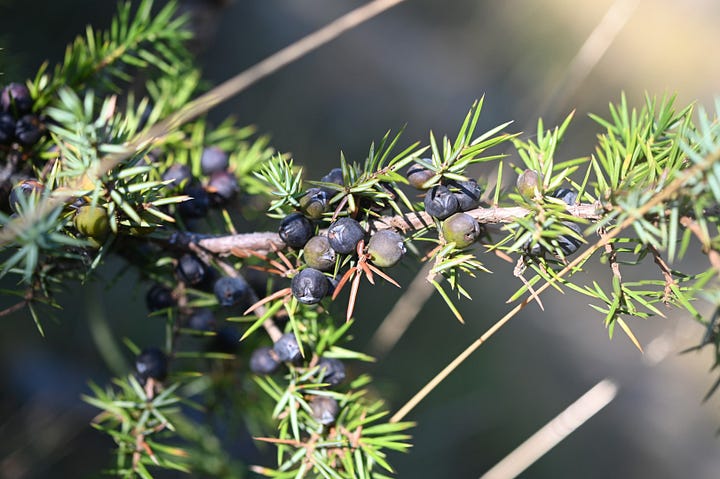
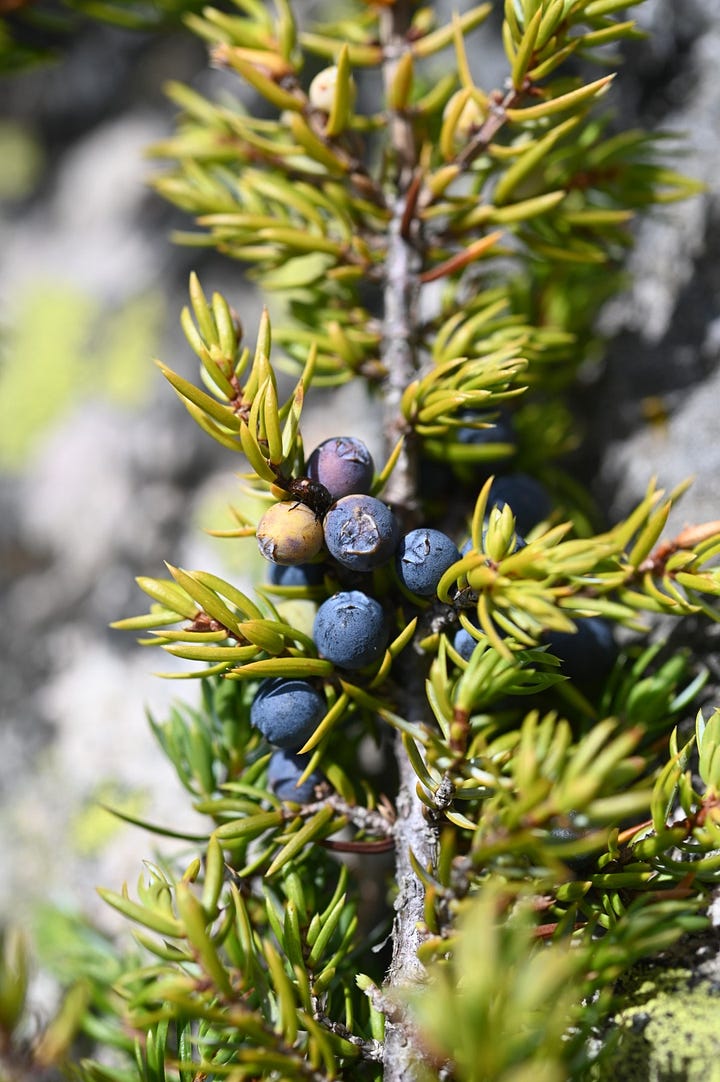

Juniperus communis is widespread in the Alps and Europe generally in a wide range of habitats. Accordingly takes a range of forms, giving rise to multiple subspecies. The two most common in the Alps are subsp. communis, which is found at lower elevations (foothills and montane zone) and can grow to be a small tree, and subsp. alpina, which dominates subalpine and alpine zones and spreads low across the ground (the better to avoid frost damage).
Juniperus sabina (rock cedar, savin/sabine)

The name “cedar” is often applied to juniper and other Cupressaceae species (a common name shared with other groups, including very different trees in the Pinaceae genus Cedrus, the “true cedars”); a more unique name for this species is savin. It’s a mountain species growing up to subalpine zones throughout Europe, Asia, and Africa. Juvenile leaves are needly and adult leaves are scaly.
Juniperus thurifera (Spanish juniper)
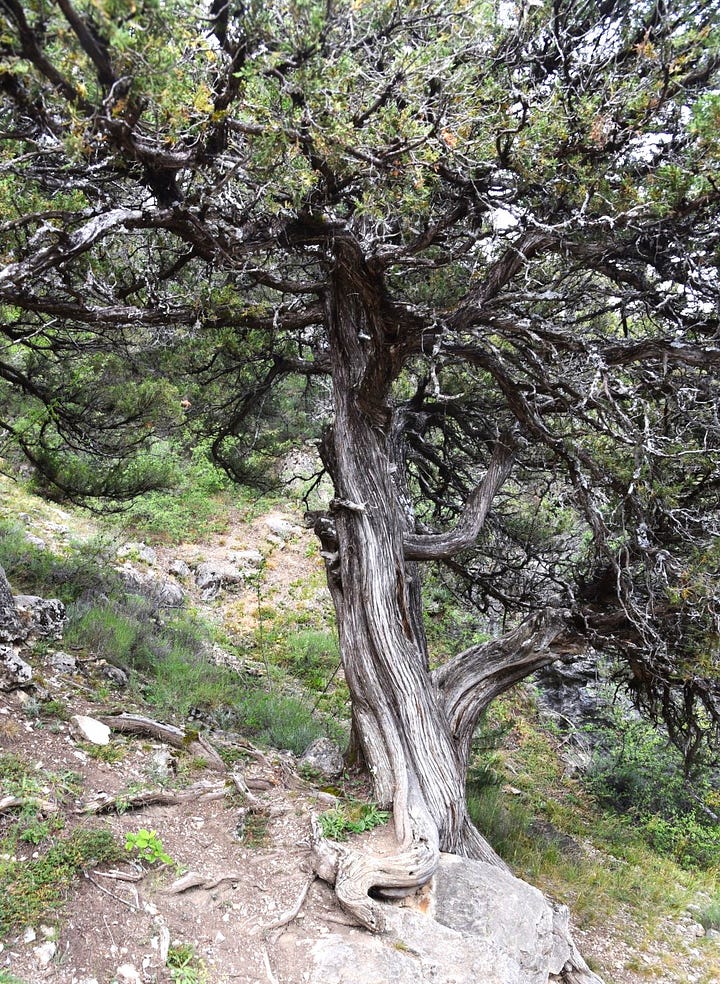
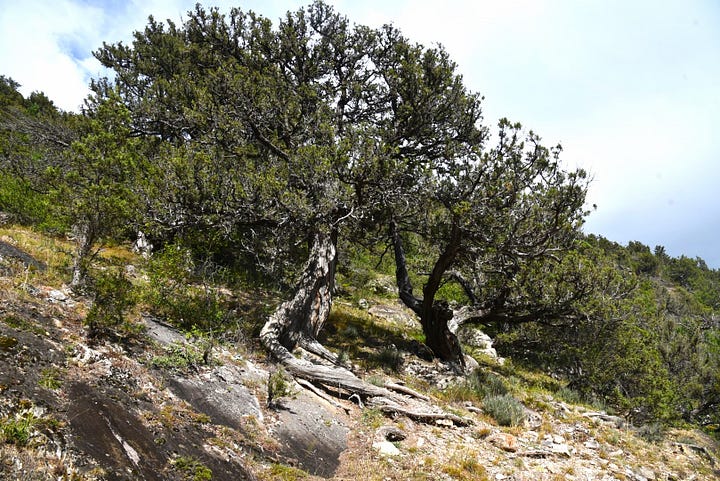
Juniperus thurifera is a Mediterranean mountain plant and is thus only found in the foothill and montane zones of the French Alps (as well as in Spain, hence the common name Spanish juniper). The rugged specimens above, recorded by Rolland Douzet,2 could be as much as 1000 years old.
Other Mediterranean junipers found chiefly in the low-elevation French Alps include J. oxycedrus (prickly juniper) and J. phoenicea (Phoenecian juniper).
Exotic Cupressaceae species
A couple of other non-native genera from Cupressaceae can be found growing wild in the Alps: Cupressus sempervirens (Italian cypress), Thuja occidentalis and Thuja orientalis (arborvitae).
Taxaceae (yew family)
Global diversity: 6 genera, 30 species
Members of note: Various yews and Torreya
Alps diversity: 1 species (Taxus baccata)
Needles: flat and flexible
Cones: simple, with fleshy aril
Taxus baccata
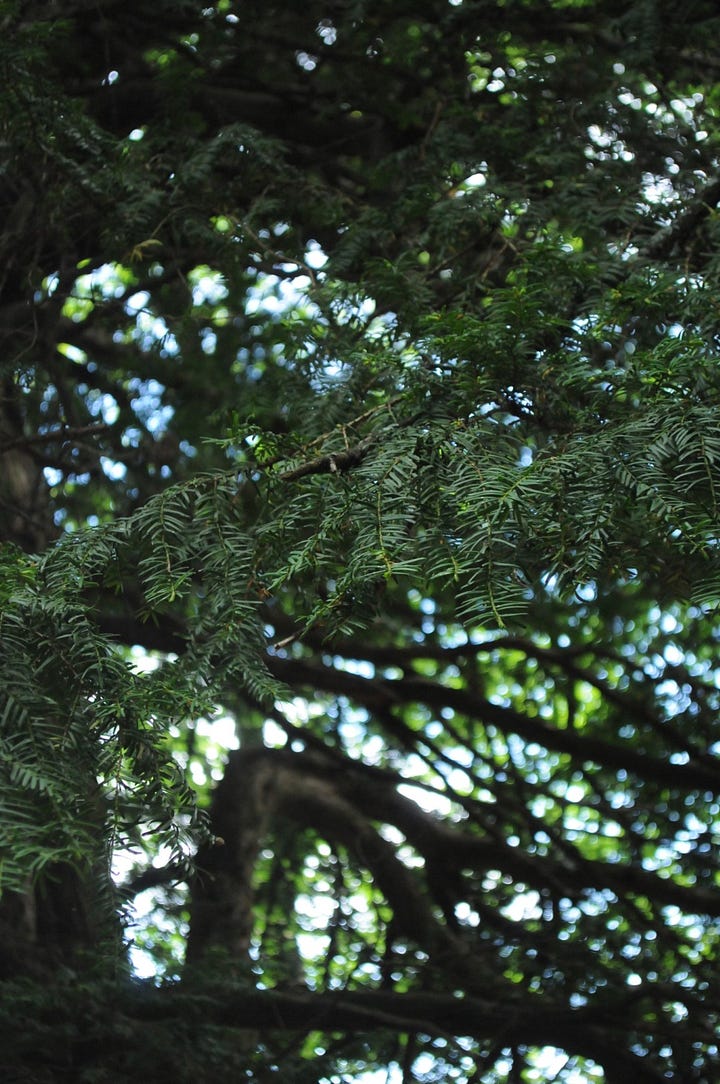
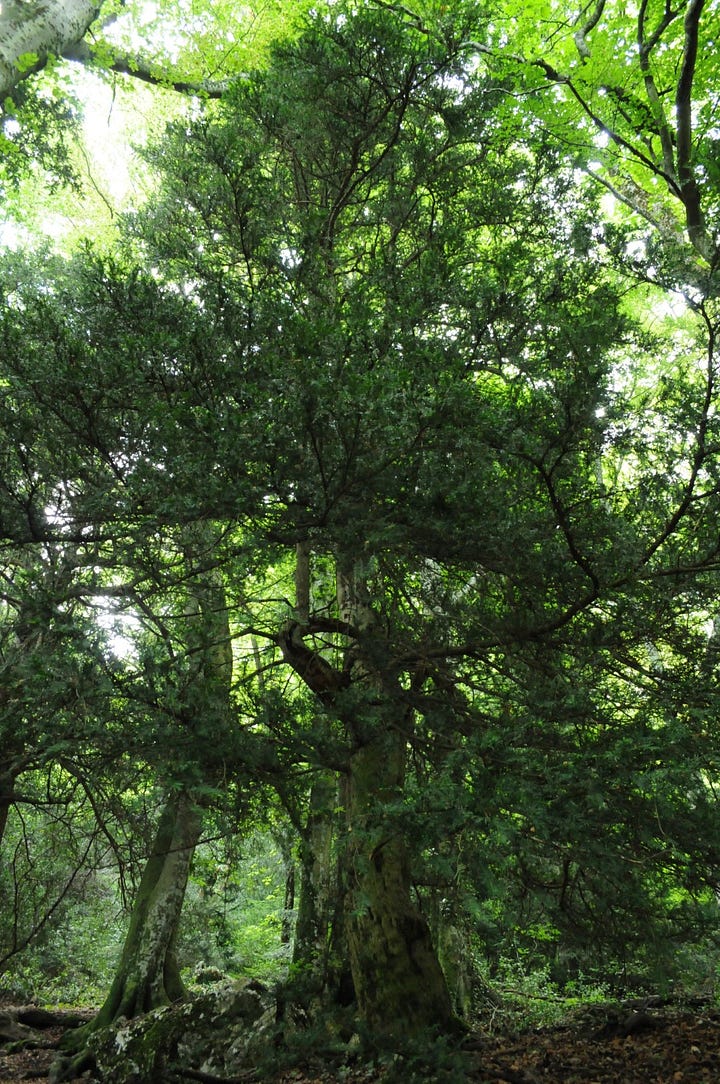

Yew trees have a long and storied human history, especially as denizens of European graveyards and as topiary hedges. But they’re also native to most of Europe and grow wild as medium-sized trees in foothill and montane woodlands. Their female cones are simple, containing a single seed. The red berry-like bit (gummy candy anyone?) is a fleshy outgrowth of bract called an aril. Everything else about the plant is highly toxic, but yew arils, like many true angiosperm fruits, are non-toxic, sweet and tempting to birds, who eat them whole and poop the unharmed seeds elsewhere.
The French common name for yew is if.
Ephedraceae (Ephedra family)
Ephedra
Global diversity: 60-70 species
Alps diversity: 2 species
Leaves: almost non-existent
Cones: fleshy fused bracts around single seed
Why is Ephedra on my list of favorite plants? First of all, because I did field research on a species of Ephedra as an unergrad in the southwest deserts of Utah, where it’s one of the dominant shrubland plants. And second, because it’s so weird.
Ephedra, made up of mostly woody shrubs, is the only genus in its family, which is not closely related to anything but a couple of other weird gymnosperms (the gnetophytes; see Bonus Gymnosperms below). So what’s weird about ephedra? The most obvious thing is that photosynthesis has been taken over by the thin, jointed stems, which grow in dense, green, broom-like bunches, while the leaves have shrunk down to tiny scales.
Similar to junipers, the bracts of its female cones (or strobili) are fleshy and fused around the seed, and like yew, are often bright red. Pollen cones resemble yellow bulbs with tassels on the ends. Both seed and pollen cones grow in clumps around the joints of the stem, giving fecund plants a very distinctive look.
Fun fact: ephedra is the source of alkaloid chemicals synthesized in medicines like pseudophedrine (as well as herbal remedies).
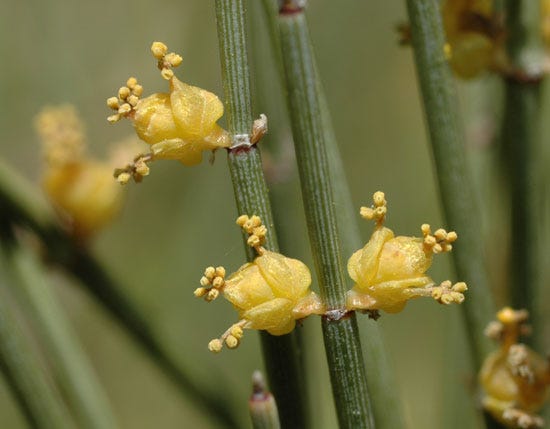
The plants are happy to reproduce by rhizomes, or underground shoots that nose through the soil and then pop up nearby with new plants. They’re often found in dense, spreading clonal clusters as a result. I was enthralled to discover this for myself when digging up Ephedra plants by the roots to study their water use in that sandy soil.
Ephedra species are well-adapted to arid conditions and are found in deserts around the world. So I was surprised to find them in the Flora alpina—what are they doing in the notably un-desertlike Alps? But there are microclimates and folds of dry habitat in any temperate zone, and these species stick to low-elevation, rocky habitats.
Ephedra major
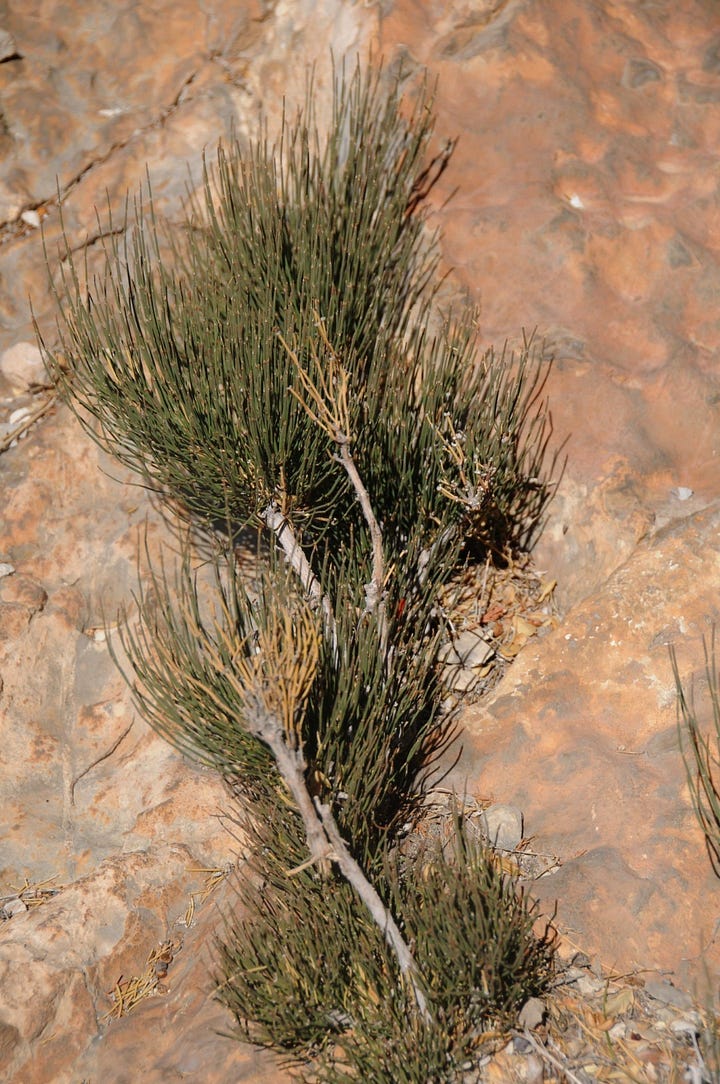
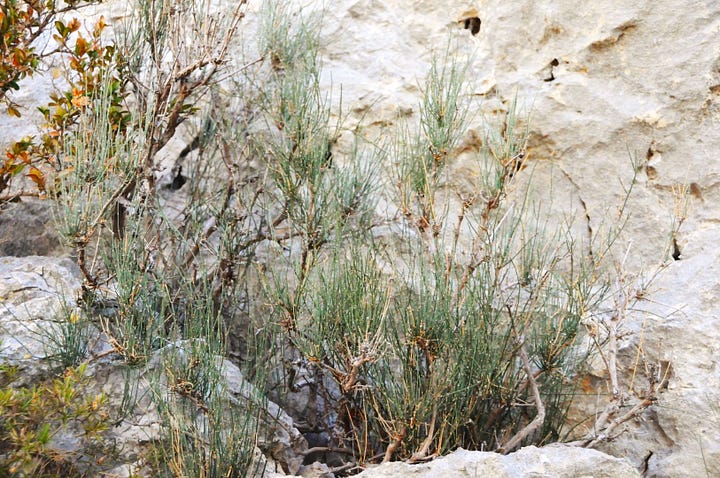
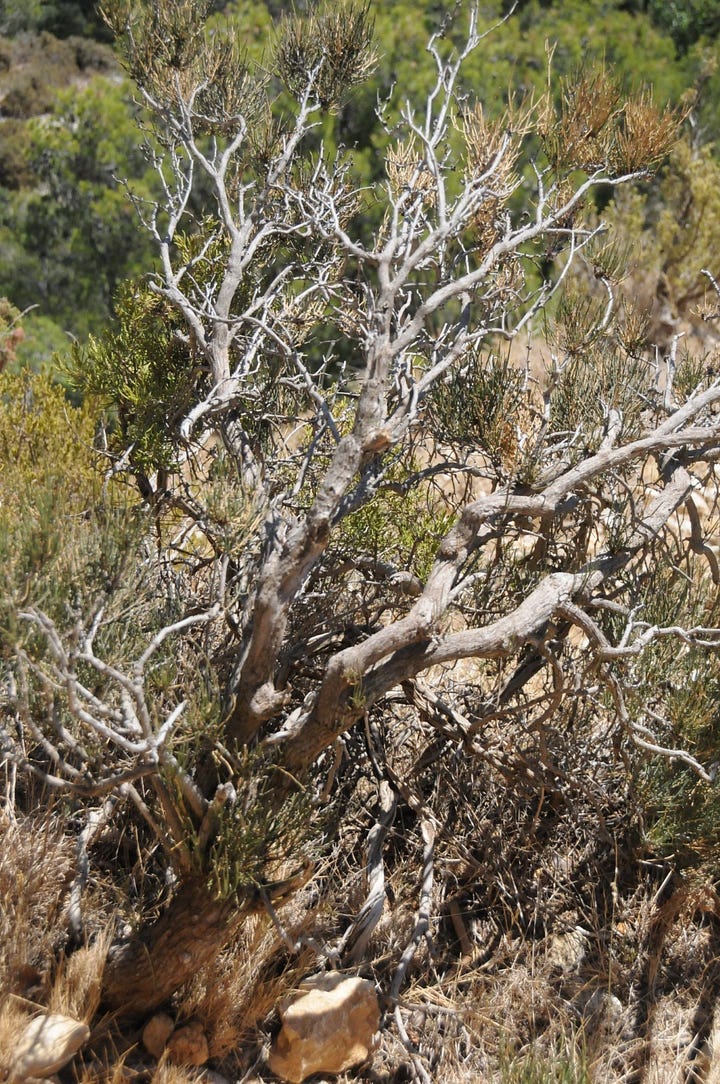
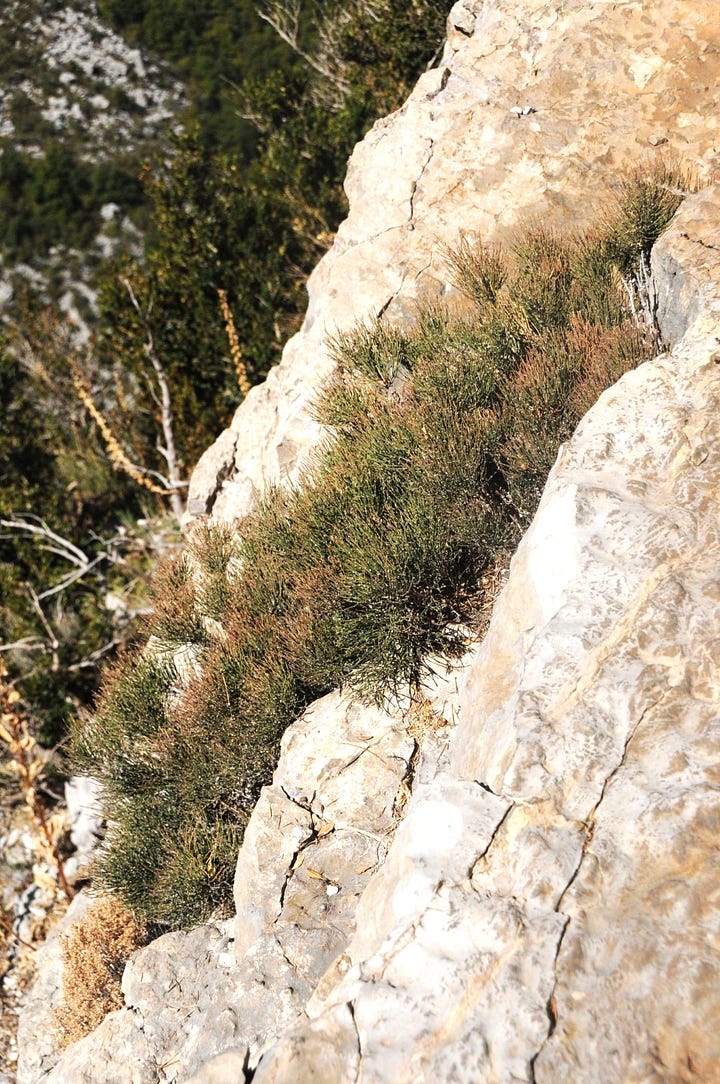
Ephedra major is a Mediterranean species with a widespread distribution outside the Alps, overlapping mostly with the French Alps. It likes limestone and other rocks.
Ephedra distyacha subsp. helvetica (Ephedra negrii)
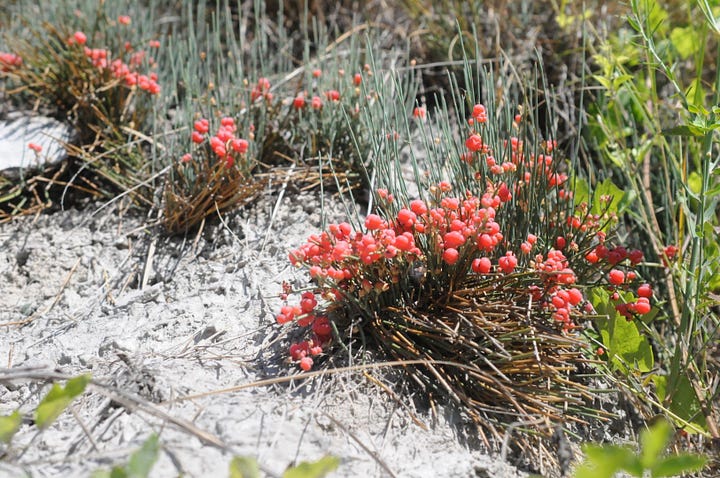
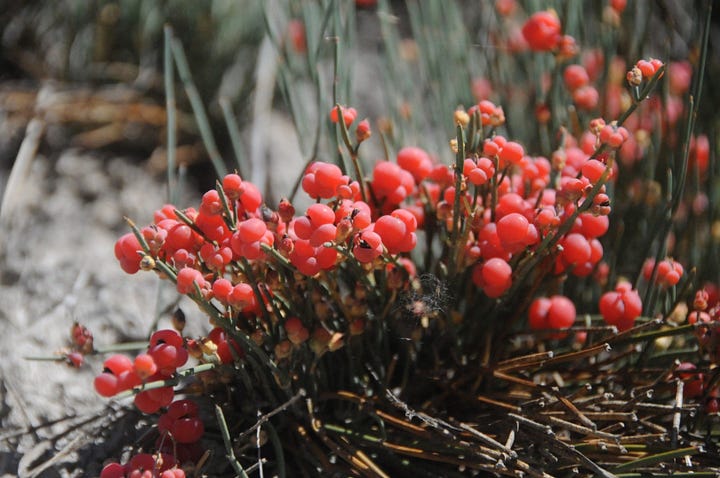
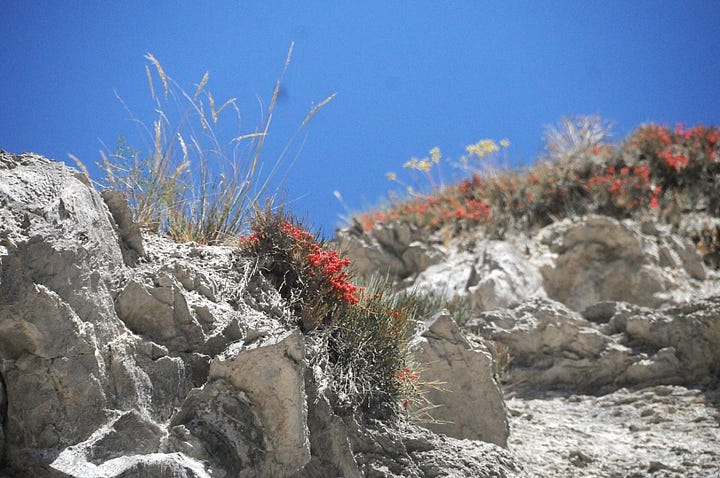
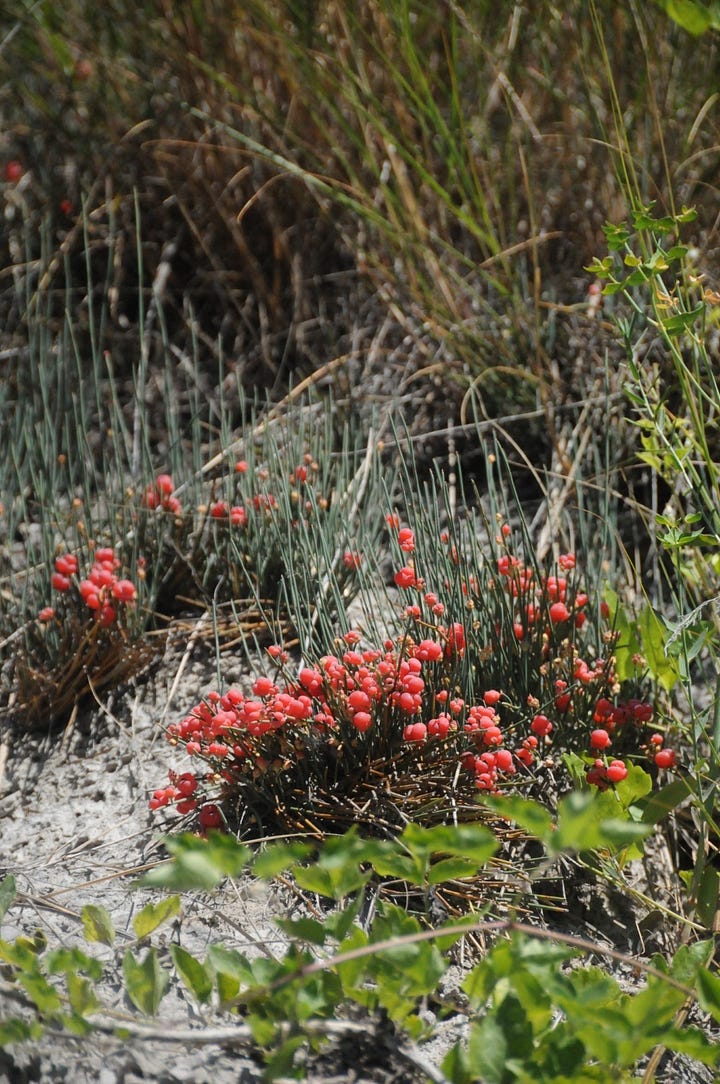
Ephedra distyacha subsp. helvetica used to be known as a separate species, Ephedra negrii or Ephedra helvetica, which was considered endemic to the Alps (one of the few endemics we’ve encountered so far in the series). As a subspecies the distinction is less clear, but the subendemic range is specific to a few valleys in the Alps. It likes dunes and steppe. Its fleshy cones give it the common name “sea grape.”
Bonus gymnosperms
The 15 or so Alpine species we’ve covered in Conifers I and II represent some of the most familiar gymnosperm groups found in the temperate Northern Hemisphere, but there are a few other really cool gymnosperms in the global collection…and I can’t help myself.
Gnetophytes
We’ve already met one of this weird group: Ephedra. The two other weird families in this group are actually nothing at all like Ephedra or each other, but aren’t related to anything else. These include:
Gnetum, the sole genus of Gnetaceae, and the only gymnosperm with angiosperm-like wood and broad, web-veined leaves (but has strobili/cones, not fruit). For a long time taxonomists thought Gnetum might be closer to angiosperms than gymnosperms, but it seems to be a case of convergent evolution. There are around 50 species of Gnetum found in the tropics.
Welwitschia mirabilis, the only species in its genus and family and class, and the weirdest of them all: the plant has a short woody crown out of which a single pair of permanent leaves grows continuously in strips, shredding into streamers as they accumulate. The female cones are oblong and reddish. It’s found only in the Namib desert and there is nothing else remotely like it. Some plants have been estimated to be 1000-2000 years old (via radiocarbon dating because they don’t have growth rings).
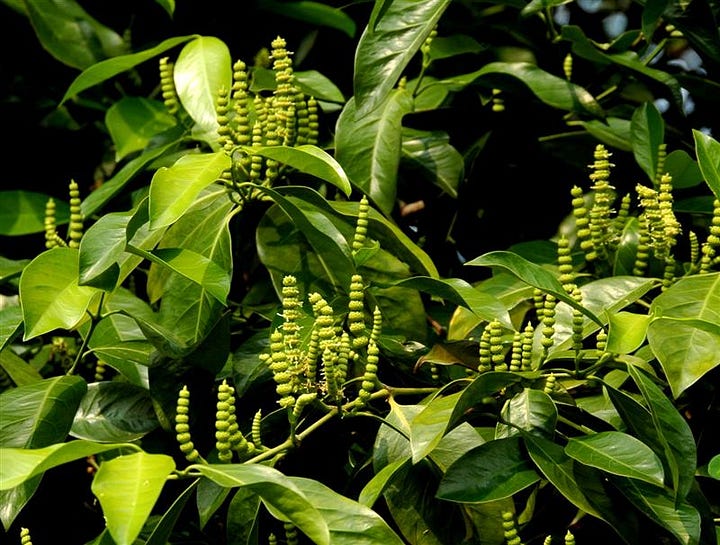
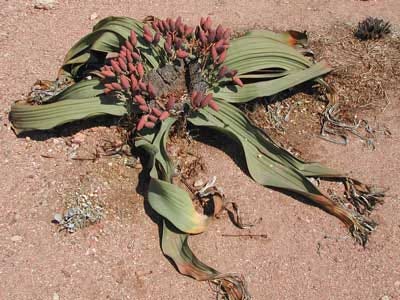
Podocarps
In the Southern Hemisphere, a whole other group of conifers is having a party without the Northerners. Instead of pines and spruces, forests in New Zealand (for example) are dominated by podocarps, which have needly or spiky or flattened leaves and often fleshy cones. Some of them are massive trees, like rimu, kahikatea3, and mataī. A related family, Araucariaceae, includes NZ kauri (also massive) and monkey puzzle trees from Chile and Argentina.

Cycads
With short, fat trunks and wide, pinnate, frond-like leaves, cycads might be mistaken for palm trees (which are angiosperms, btw) or tree ferns, but they are not either of these—they have big, fat cones. Cycads had their day during the Mesozoic era (think dinosaurs) and are less abundant now, but still contribute to the jungly feel of tropical and subtropical habitats. They’re often pollinated by highly specialized beetles, unusual for a gymnosperm.
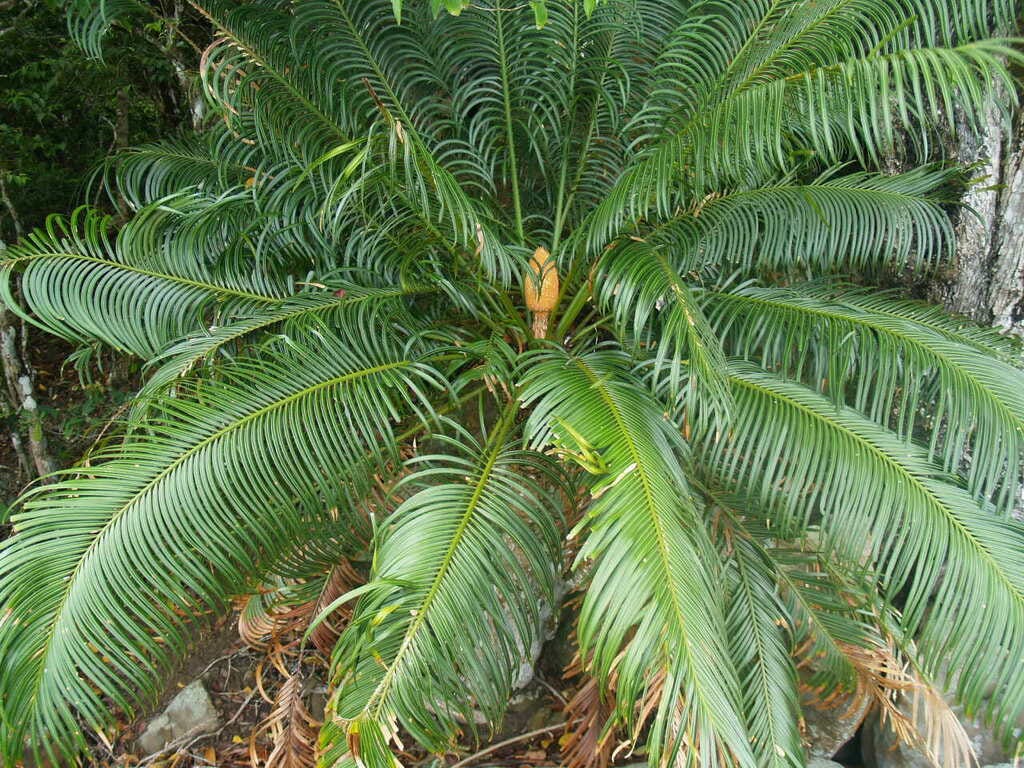
Ginkgo
The last one may be a surprise: Ginkgo biloba, another evolutionarily isolated weirdo, is a gymnosperm. Its deciduous, fan-shaped leaves, with a forking vein pattern found in no other plant, show up relatively unchanged in the fossil record back to the Jurassic period. Their fleshy, smelly seed cones kind of resemble apricots or plums (but—say it with me—they’re not fruit!). Ginkgos are native to China, but are beloved ornamental trees all over the temperate zone (including the valleys of the Alps).
Gymnosperm phylogeny
This phylogenetic tree below shows how all the groups mentioned in these posts are related to each other. Pinaceae (teal) includes a cluster of familiar conifers, and the Cupressidae sub-class (blue) encompasses the other conifers. The gnetophytes (purple) are difficult to place, and several competing hypotheses have seen them jumping around the tree, but the best-supported one links them to Pinaceae. However, this plunks them right in the middle of the groups we call conifers. Are gnetophytes conifers? They’re so different from the others that some taxonomists have decided to exclude them, splitting the conifers into two.
Despite their differences, ginkgo and cycads are probably more closely related to each other than the rest of the tree, but it’s uncertain.

Up next in Flora alpina
Finally some flowers! Weird ones though. Early angiosperms: magnoliids and water lilies.
Glossary
Genus (plural genera), family, order, class: In taxonomy, progressively higher organizational levels above species
-aceae (ay-see-ee): Suffix of a plant family
Seeds: specialized containers for plant embryos
Spermatophyta: the part of the Plant Tree of Life encompasing plants that reproduce by seeds (as opposed to spores, like ferns and lycophytes)
Gymnosperms: seed plants without fruits, only “naked seeds” growing on bracts
Angiosperms: seed plants which enclose their seeds in fruits
Conifer: A plant with cones, typically referring to Pinaceae and Cupressidae (Cupressaceae, Taxaceae, podocarps)
Cones: specialized clusters of fertile leaves (bracts) bearing ovules or pollen
Strobilus (plural strobili): A more general term for a cluster of fertile leaves (includes plants that aren’t conifers or gymnosperms)
Ovules: female reproductive structures which become seeds when fertilized (actually a female gametophyte—see glossary for ferns)
Pollen: male gametophyte containing male reproductive cells
Aril: a specialized fleshy bract (seen on yews)
Rhizome: an underground shoot that can establish new vegetative growth
Pinnate: describes a leaf divided into parallel leaflets
Microclimate: environmental conditions specific to a small topographical area
Endemic: a species found only in a specific region
Convergent evolution: describes similar features found in organisms that are not closely related, so they didn’t both inherit the feature from a common ancestor but evolved them independently, often due to similar evolutionary pressures
Deciduous: a plant that loses leaves seasonally (in winter) and regrows them
Exotic (or non-native) species counts come from the Flora alpina, which includes non-native species that are found in the wild in the Alps. These numbers might be out of date.
Rolland Douzet is the current co-director of the alpine botanical garden Jardin du Lautaret and kindly provides most of the photos for these posts.
Kahikatea (the Maori name) is often called “white pine” and matai, “black pine,” in English but neither are related to Pinaceae pines.






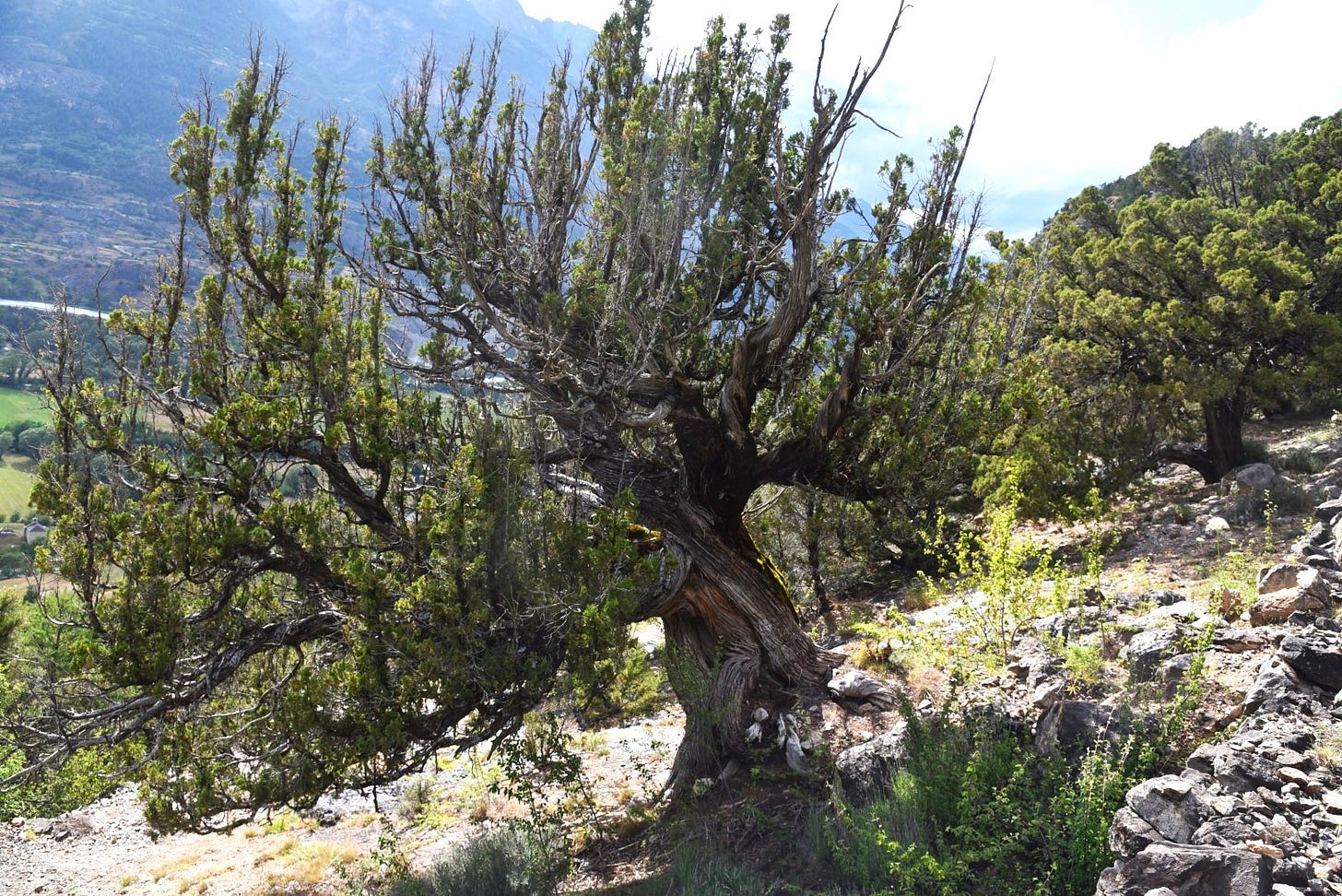
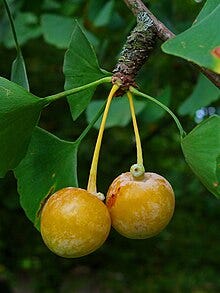

Wow super interesting article I love learning about conifers and their evolution!
Great post Anne, thank you. We have an old yew in our garden and I have always thought they were berries on it, but I will never make that mistake again! They’re cones, not fruit 😅